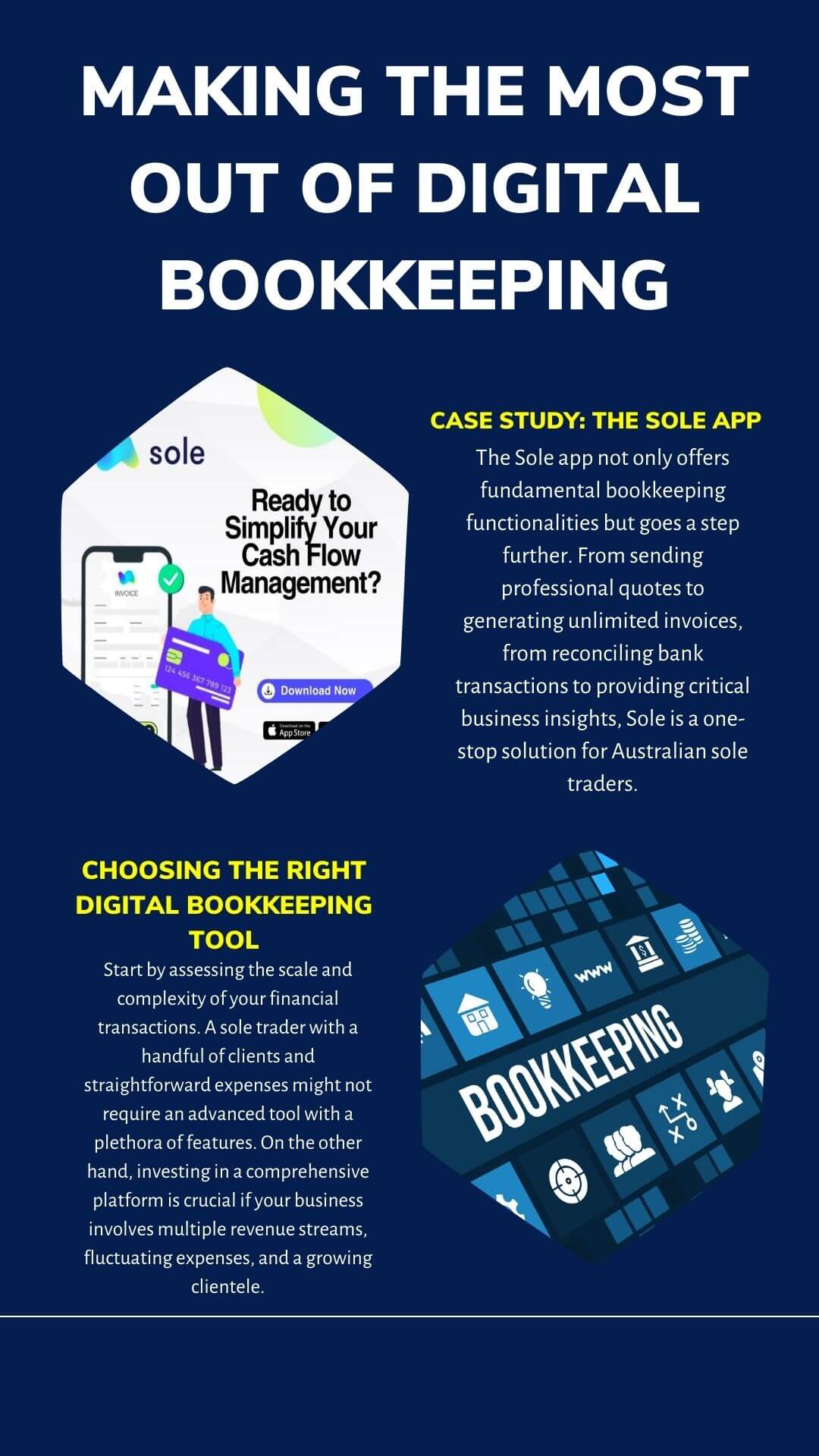In today’s fast-paced digital era, the world of bookkeeping has evolved significantly, especially for the often-overlooked category of sole traders in Australia. Gone are the days when bookkeeping meant poring over physical ledgers, receipts, and spreadsheets. Instead, the future—and indeed, the present—belongs to digital bookkeeping. This comprehensive guide sheds light on the transformative world of digital bookkeeping tailored to the unique needs of Australian sole traders.
Basics Of Digital Bookkeeping For Sole Traders
Digital bookkeeping revolves around the use of technology, especially software and apps, to manage, organise, and analyse financial data. For sole traders, this transition from traditional to digital can be incredibly liberating. Imagine replacing stacks of paperwork with sleek, interactive dashboards or swapping out manual calculations for automated reports.
The key advantages of digital bookkeeping for sole traders are numerous. Firstly, the efficiency is unparalleled. Tasks that once took hours can now be accomplished in minutes. Moreover, the risk of human error, which can be financially costly, is significantly reduced. Lastly, digital tools often come equipped with features that facilitate compliance with local regulations, a boon for sole traders in Australia navigating the intricate web of financial laws.
Also Read: Is It Illegal To Be A Personal Trainer Without Certification?
Legal And Financial Implications In Australia
Australia has a distinct set of regulations and requirements regarding taxation and bookkeeping for sole traders. While these laws ensure financial integrity, they can often seem daunting to the uninitiated.

One of the standout benefits of digital bookkeeping tools tailored for Australians is their alignment with local regulations. These tools often come with features that automatically categorise expenses, calculate taxes, or even generate reports as per the Australian Tax Office (ATO) guidelines. Such functionalities save time and ensure that sole traders don’t inadvertently run afoul of the law.
However, with these benefits also come responsibilities. Sole traders must ensure their digital tools are up to date with the latest regulatory changes. Moreover, relying too heavily on automation without understanding the underlying principles can be a pitfall. Hence, while digital tools can be invaluable, a basic understanding of Australian financial regulations remains paramount.
Key Components Of Effective Digital Bookkeeping
At the heart of effective digital bookkeeping lie several core components:
- Organising Financial Records Digitally: The foundation of digital bookkeeping is the electronic organisation of financial records. This can range from digital ledgers to cloud-stored receipts. Tools that allow seamless categorisation and tagging can make retrieval effortless and timely.
- Automated Invoicing and Reminders: Every minute counts in the dynamic world of sole trading. Digital tools that offer automated invoicing, coupled with reminders, ensure that revenue streams are consistent and timely.
- Tracking and Reconciling Transactions: One of the main advantages of digital over traditional bookkeeping is real-time transaction tracking. Many tools now offer direct bank integration, allowing for live feeds of transactions to be automatically reconciled.
- Accessing and Analyzing Financial Reports: In the end, bookkeeping is about recording and understanding financial data. Digital bookkeeping tools often come with analytical dashboards, making it easier for sole traders to gain insights into their financial health.
The Role Of Technology In Digital Bookkeeping
Technology is the driving force behind digital bookkeeping. Technology is making it easier than ever for sole traders to maintain their books, from user-friendly mobile apps to sophisticated desktop software.
An essential aspect of this technological shift is the cloud. Cloud storage facilitates anywhere, anytime access, ensuring that bookkeeping isn’t confined to a desk or office. Moreover, it offers enhanced security, given that data isn’t susceptible to physical threats like theft or damage.

However, with great power comes great responsibility. The increased reliance on technology means that sole traders must be vigilant about security. Thankfully, many modern bookkeeping tools prioritise security, incorporating features like encryption, two-factor authentication, and regular backups.
Also Read: How To Sell Personal Training: Expert Tips For Success
Making The Most Out Of Digital Bookkeeping
Merely adopting a digital bookkeeping tool isn’t enough; sole traders must use it effectively to reap the benefits truly. Regular reviews of financial data, even if it’s automated, are crucial. Moreover, timely reminders can be a game-changer, especially for crucial tasks like tax submissions or invoice follow-ups.

Case Study: The Sole App
The Sole app stands out in the vast world of digital bookkeeping tools tailored for Australian sole traders. Designed with the unique needs of sole traders in mind, it offers a suite of features that streamline bookkeeping tasks.
The Sole app not only offers fundamental bookkeeping functionalities but goes a step further. From sending professional quotes to generating unlimited invoices, from reconciling bank transactions to providing critical business insights, Sole is a one-stop solution for Australian sole traders.
But it’s not just about features. The user experience is intuitive, with an interface designed for both novices and seasoned traders. The emphasis on cloud storage ensures that users can capture receipts on the go, making expense tracking a breeze. Moreover, with bank-grade security, users can have peace of mind about their data’s safety.
Choosing The Right Digital Bookkeeping Tool
With abundant digital bookkeeping tools available, Australian sole traders may find themselves overwhelmed by choice. The key lies in understanding your unique business needs and then matching them to the features offered by these platforms.
Start by assessing the scale and complexity of your financial transactions. A sole trader with a handful of clients and straightforward expenses might not require an advanced tool with a plethora of features. On the other hand, investing in a comprehensive platform is crucial if your business involves multiple revenue streams, fluctuating expenses, and a growing clientele.
Also Read: How To Find A Personal Trainer For Seniors Today
Another critical factor is the learning curve associated with the tool. Time spent figuring out complex interfaces or troubleshooting software glitches is time away from growing your business. Opt for tools known for their intuitive design and reliable customer support.
Lastly, consider the integration capabilities. A good digital bookkeeping tool should seamlessly integrate with other business software, be it CRM systems, payment gateways, or e-commerce platforms. Such integrations save time and ensure that your financial data is consistent across all platforms.
Conclusion
Digital bookkeeping represents a revolution for Australian sole traders, offering efficiency, compliance, and insights. As the world continues its relentless march towards digitisation, those who embrace these tools will undoubtedly have an edge. With platforms like the Sole app leading the charge, the future of bookkeeping for Australian sole traders looks promising indeed.


